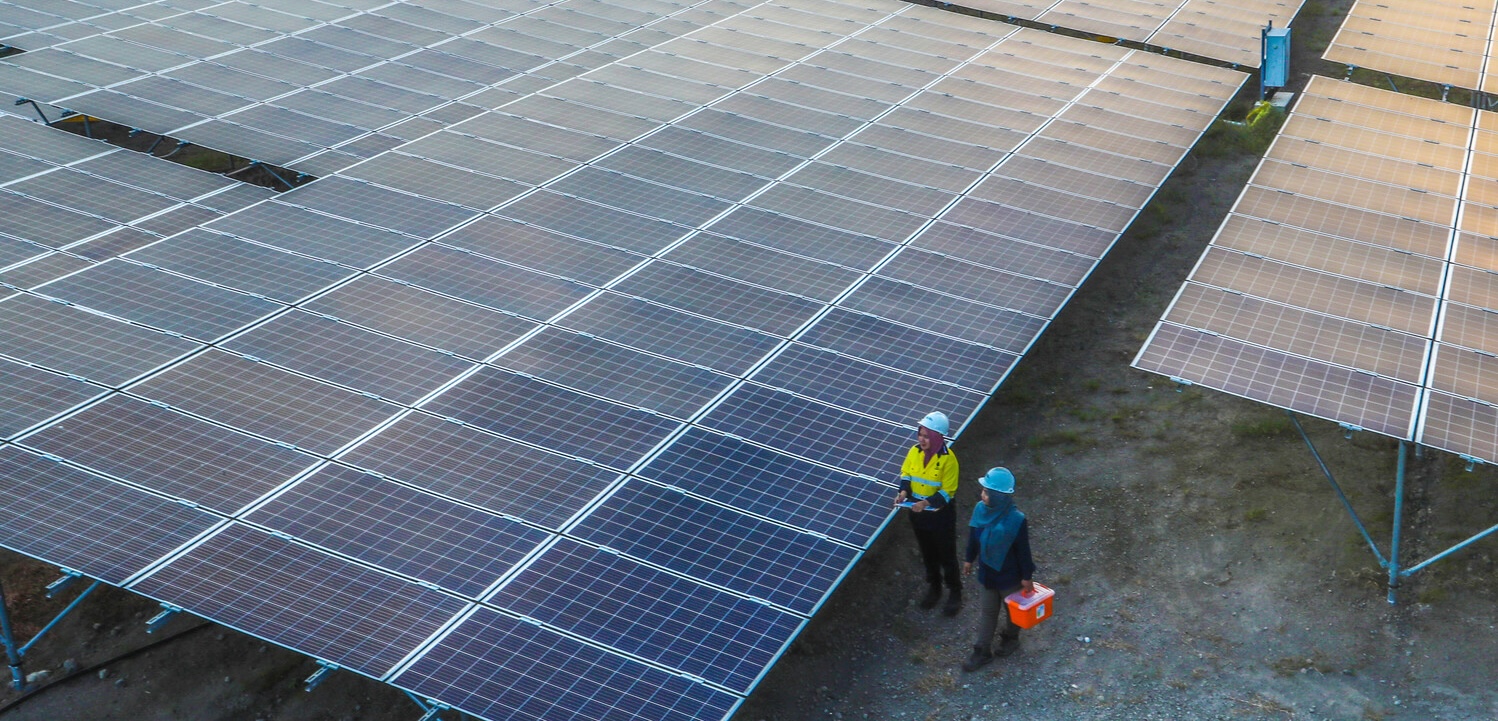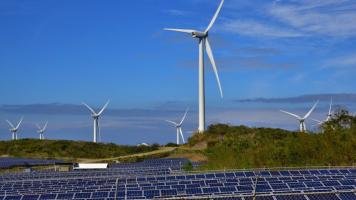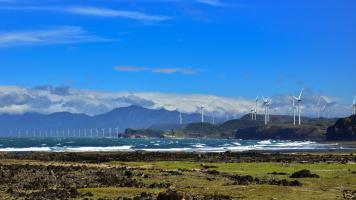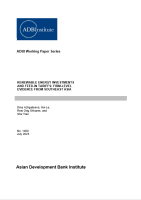Harnessing the Potential of Renewable Energy Certificates to Finance ASEAN’s Energy Transition

ASEAN needs $3.7 trillion to $6.7 trillion in green investments. Setting up a regional enewable energy certificate system is expected to increase investments in renewable energy and help realize the ASEAN Power Grid vision of a fully integrated system by supporting cross-border electricity trade. Photo credit: ADB.
A project supported by the BIMP-EAGA–Republic of Korea Fund provides a conceptual framework for creating a regional market.
A regional system for trading renewable energy certificates (RECs) in Southeast Asia is on the drawing board. Taking the concept through to implementation will be challenging given policy and regulatory gaps and the need for common rules and standards.
An REC is a market-based instrument that is issued when 1 megawatt hour (MWh) of electricity is produced and delivered to the power grid from renewable sources (e.g., solar, wind).
For the past 2 years, the ASEAN Centre for Energy (ACE) has been working on a conceptual framework for integrating the REC markets in Brunei Darussalam, Indonesia, Malaysia, and the Philippines into a single market as a pilot for the ASEAN region. The Renewable Energy Certificate System in BIMP-EAGA Countries Project (RECAP) is backed by a grant from the BIMP-EAGA–Republic of Korea Cooperation Fund (BKCF). The draft conceptual framework has been submitted to the countries for their review and feedback.
The Jakarta-based think tank sees RECs as a potential game changer in bridging the financing gap that stands in the way of climate goals. To achieve carbon neutrality by 2050, ASEAN needs $3.7 trillion to $6.7 trillion in green investments. Setting up a regional REC system is expected to increase investments in renewable energy and help realize the ASEAN Power Grid vision of a fully integrated system by supporting cross-border electricity trade.
A type of energy attribute certificate, RECs play a key role in national energy reporting and enable end-users to claim reductions in carbon emissions. The certificates can be sold by the electricity producer to consumers through a book-and-claim mechanism. Buyers may purchase unbundled or “certificate-only” RECs.
Research by SUSCA Group shows the volume of ASEAN RECs surged in the last 8 years with the I-REC registry issuing 56.9 million certificates and TIGR registry, nearly 6 million in 2023 from only 277,348 and 7,456 in 2015. These represent claims for renewable energy that was generated and consumed within the domestic market or the same grid. At present, there is no cross-border transfer of RECs associated with grid-to-grid power trade in ASEAN. In January, Malaysia and Singapore, which is importing green electricity from Malaysia, announced that they are studying a framework for recognizing cross-border certificate procurement.
In this interview, Monika Merdekawati and Veronica Ayu Pangestika of ACE’s Sustainable and Renewable Energy Department share findings, lessons, and insights from the BKCF-funded project. Through RECAP, ACE gained wider and deeper knowledge of the market in each country and the region. Discussions with the countries also created serious interest in improving their national system for issuing, certifying, and trading RECs.
Why does ASEAN need a regional renewable energy certificate system?
Global demand for RECs is largely driven by the private sector, particularly multinational corporations that have voluntarily committed to clean energy goals (such as under the global corporate initiative RE100). All ASEAN member states have a functioning voluntary REC market, but they are operating in relative isolation from one another.
While unified REC tracking systems, such as the I-Track Standard, are widely used in ASEAN, governance functions vary for each country, and there is currently no single regional entity tasked to unify the countries’ perspectives on REC issues, such as ownership disputes of green power generation between independent power producers and utilities.
Regionalizing the REC market can deliver the following benefits for ASEAN:
- (i) strengthen guidance and ensure accuracy of information for all market actors;
- (ii) improve REC market health and strengthen measurement, reporting, and verification systems for cross-border transactions
- (iii) facilitate cross-border REC transactions in accordance with the technical requirements of international reporting frameworks, namely CDP (formerly known as the Carbon Disclosure Project), RE100, and Science-Based Targets Initiative (SBTi); and
- (iv) deepen regional cooperation in market oversight.
What are the opportunities and challenges in setting up a regional system?
One of the means to authenticate clean energy use is through RECs. Regional cooperation in RECs presents countries in ASEAN with significant opportunities to enhance their renewable energy markets.
RECs can play a complementary role in supporting energy sector goals by increasing the attractiveness of renewable energy projects to investors. The sale of RECs as a secondary revenue stream for renewable energy producers can reduce the need for public sector subsidies and improve the bankability of projects. This enhanced financial viability of projects linked to REC sales will increase capacity especially in countries with ample renewable energy resources. Through interconnections in the ASEAN Power Grid, member states will have access to increased supply of not only green electricity but also the associated RECs, providing opportunities for cross-sectoral stakeholders to decarbonize.
RECs can become a key enabler of the ASEAN Power Grid. However, it is important for cross-border transactions that bundle the renewable energy produced and the corresponding RECs to be recognized by international reporting frameworks, namely CDP, RE100, and SBTi. These disclosure frameworks, though not legally binding, provide the technical criteria used by multinational corporations to comply with international sustainability reporting standards.
As of now, these international reporting frameworks accept only the cross-border REC transactions of selected markets in the European Union and North America (United States and Canada). In these markets, cross-border certificate procurement is considered as an intra-market transaction.
Lack of international recognition may lessen the attractiveness of cross-border ASEAN RECs even if such transactions are bundled with electricity. This may also affect buyers’ decision to procure clean electricity from another country at a premium and the financial viability of regional transmission projects.
Establishing a regional REC market framework and a regional entity tasked to represent the interests of ASEAN member states are critical in gaining international recognition for cross-border REC transactions in ASEAN. The regional REC framework will provide guidelines on best practices in line with international tracking systems and global reporting frameworks. In addition, it will harmonize national REC standards in preparation for creating a regional market.
The regional entity, envisioned as a regional or subregional REC Taskforce can take the lead in engaging relevant stakeholders in dialogue, formalize the criteria for qualification and crediting as best practices in ASEAN, and present them as a collective aspiration to global reporting frameworks. This regional entity will comprise the local issuer or, in its absence, a nationally appointed regulatory body from each ASEAN member state.
Why were BIMP-EAGA countries selected as a pilot for developing the conceptual framework for a regional REC system?
Under the ASEAN Power Grid, bilateral and subregional interconnectors that link the electricity systems of neighboring countries are poised to support regional power interconnections.
Initially, ACE saw the development of a regional market for RECs as an additional benefit that would encourage ASEAN member states to pursue the ASEAN Power Grid even more. At the time of project conceptualization, Brunei Darussalam, Indonesia, Malaysia, and the Philippines were moving toward a subregional power interconnection project (now known as BIMP-PIP), building on the Trans-Borneo Power Grid Sarawak–West Kalimantan Interconnection Project in BIMP-EAGA. Energized in January 2016, the grid-to-grid transmission line enables electricity imports from Sarawak's hydropower sources to West Kalimantan.
Through the BIMP-PIP, the subregion is collaborating on grid interconnectivity and market alignment, thus creating ideal conditions for evaluating a subregional REC market design that can be scaled to the regional level. BIMP-PIP interconnections form part of the eastern subregion of the ASEAN Power Grid. These include plans to connect Sarawak and Brunei Darussalam, Sarawak and Sabah, North Kalimantan and Sabah, and Sabah and Palawan.
How is the BIMP-EAGA-ROK Cooperation Fund helping with the project?
The BKCF provides the funding for the project. Seoul-based Global Green Growth Institute (GGGI), which manages the BKCF, also serves as the project delivery partner, providing expert opinion on the formulation of the conceptual framework for BIMP-EAGA countries. GGGI brings to the project the experience and know-how of its member countries, particularly the Republic of Korea.
The project opened the discussions with BIMP-EAGA countries on RECs, which helped ACE gain deeper knowledge of the markets, while the countries learned more about market regulation and governance. It also brought out the role of the private sector as the main driver of the REC market and the need for closer collaboration between the public and private sectors on such issues as governance.
What needs to be done to create an effective and efficient regional REC system?
Enhance harmonization. Market participants (end users and traders) across the four countries have employed the same tools and platforms—the I-REC(E) Code as the common standard and Evident as a registry for the voluntary market.
The Philippines is the only one in the region that has both compliance and voluntary REC markets. There is a need to integrate the two markets to prevent double counting or double claiming of the environmental attributes of RECs and ensure fair pricing.
A step toward deeper harmonization is formalizing cross-border arrangements at the subregional or regional level through memorandums of understanding or a technical REC framework for BIMP or ASEAN. These will help standardize best practices and ensure that trade participants follow the same rules and methodologies.
Create a regional (or subregional) entity. The proposed ASEAN REC Taskforce will facilitate coordinated REC planning and implementation, providing technical guidance to national authorities. Its formalization will support the region in creating a cohesive structure for REC market oversight and governance. It will represent ASEAN member states’ collective position in international discussions on REC. Among the issues expected to be raised are hydropower-backed RECs. Hydropower remains the dominant source of renewable energy in the region. However, hydropower RECs are valued less than solar and wind RECs in the market.
Follow global best practices. Based on the best practices developed in the EU and North America (US and Canada), the key features of a unified regional REC market are as follows:
(i) the use of common REC instruments across participating countries;
(ii) the co-development of common guidelines/frameworks on using REC instruments and sustaining long-term market growth; and
(iii) the designation of entities at the country level to represent national interests in REC regional and global forums.
Findings from the RECAP project also show that among the four countries, Malaysia offers the best case for advancing REC markets. The power sector is vertically integrated with state-owned power utility Tenaga National Berhad (TNB) responsible for electricity generation, transmission, and distribution. Its subsidiary TNBX manages the utility's REC program. With this setup, REC sales are expected to directly contribute to achieving Malaysia’s target of increasing renewable energy in its installed power capacity to 70% by 2050.
Align with the requirements of international disclosure frameworks. There are three conditions for cross-border RECs to be considered credible. First, participating countries should have common rules governing electricity markets. Second, renewable energy consumption claims should come from fully interconnected grids. Third, there should be a common method for calculating the residual mix, which is used in greenhouse gas accounting.

BIMP-EAGA
The Brunei Darussalam–Indonesia–Malaysia–Philippines East ASEAN Growth Area, or BIMP-EAGA, is a cooperation initiative established in 1994 to spur development in remote and less developed areas in the four participating Southeast Asian countries.


